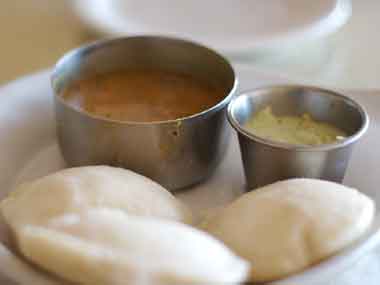US Secretary of State Hillary Clinton, who is on a three-day visit to India, was treated to the finest South Indian fare of rawa upma with cashew nuts and fresh coriander, medu wada and podi with ghee for a breakfast meeting with External Affairs Minister SM Krishna in New Delhi today. The spread also included kesari bhaat, uthapam (masala/plain), dosa (masala/plain), steamed idlis and drumstick sambhar. Coconut and tomato chutneys were also part of the all-South Indian thali breakfast, reports DNA. Clinton was also served masala tea and south Indian coffee, officials said, adding the selection for breakfast menu was a departure from tradition. In the past, the spread has always included different Indian cuisines. [caption id=“attachment_302075” align=“alignleft” width=“380” caption=“The idli is an import from Indonesia. Image courtesy Roland from Flickr”]  [/caption] Speaking of Indian cuisines, as much as we think idlis and dosas to be ‘ours’, fact is the idli was probably an import from what is now Indonesia (and what was then the Sri Vijaya empire), says Nitin Pai. Indonesia which has a long tradition of fermented products, like tempeh (fermented soy cakes), kecap (from where we get ketchup) or something called kedli, which is like an idli, says Pai quoting KT Acharya’s theory. Legend has it that spices like the chillies in the chutney and the tomatoes in the sambar also came from the Americas with the Europeans, says Pai. And, if Pai is to be believed beverages like tea and coffee are also not typically ‘Indian’. Pai illustrates in his column that a 17th century Sufi from Karnataka broke the Arabian monopoly on coffee. Legend has it that on his pilgrimage to Mecca in the middle 1600s, Baba Budan smuggled seven coffee beans out of Arabia and on his return home planted the beans in the hills of Mysore. Coffee flourished in the hills of India – hills now named after Baba Budan. Pai adds that even tea was probably grown and consumed in India long before the British arrived. “We have to accept that tea as we drink it today is largely a gift of their colonial rule,” he says. Would we still say we served Ms Clinton the finest south ‘Indian’ fare? Wasn’t there more than one ‘foreign hand’ in the ‘traditional’ South Indian breakfast menu?
US Secretary of State Hillary Clinton was treated to the finest south Indian fare of idli, dosa, uthapam, upma for a breakfast meeting with SM Krishna in the Capital today. Read on to know why these south Indian dishes may not be ‘Indian’ at all.
Advertisement
End of Article


)

)
)
)
)
)
)
)
)



